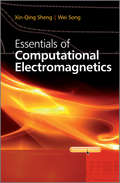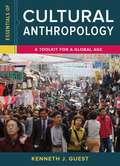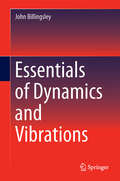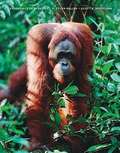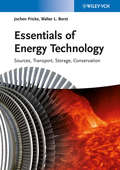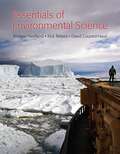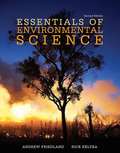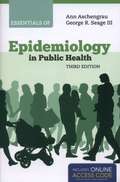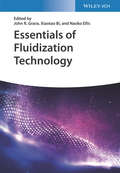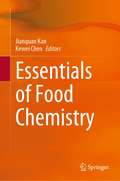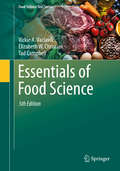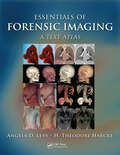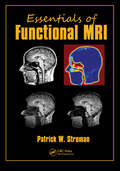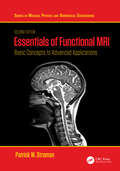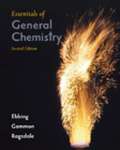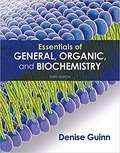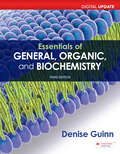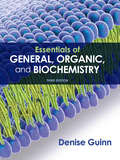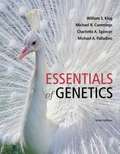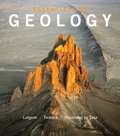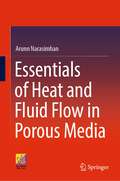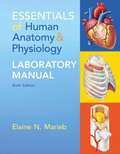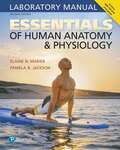- Table View
- List View
Essentials of Computational Electromagnetics (Wiley - IEEE #757)
by Xin-Qing Sheng Wei SongEssentials of Computational Electromagnetics provides an in-depth introduction of the three main full-wave numerical methods in computational electromagnetics (CEM); namely, the method of moment (MoM), the finite element method (FEM), and the finite-difference time-domain (FDTD) method. Numerous monographs can be found addressing one of the above three methods. However, few give a broad general overview of essentials embodied in these methods, or were published too early to include recent advances. Furthermore, many existing monographs only present the final numerical results without specifying practical issues, such as how to convert discretized formulations into computer programs, and the numerical characteristics of the computer programs. In this book, the authors elaborate the above three methods in CEM using practical case studies, explaining their own research experiences along with a review of current literature. A full analysis is provided for typical cases, including characteristics of numerical methods, helping beginners to develop a quick and deep understanding of the essentials of CEM. Outlines practical issues, such as how to convert discretized formulations into computer programs Gives typical computer programs and their numerical characteristics along with line by line explanations of programs Uses practical examples from the authors' own work as well as in the current literature Includes exercise problems to give readers a better understanding of the material Introduces the available commercial software and their limitations This book is intended for graduate-level students in antennas and propagation, microwaves, microelectronics, and electromagnetics. This text can also be used by researchers in electrical and electronic engineering, and software developers interested in writing their own code or understanding the detailed workings of code. Companion website for the book: www.wiley.com/go/sheng/cem
Essentials of Cultural Anthropology: A Toolkit for a Global Age
by Kenneth J. GuestThe most successful new textbook for living in a multicultural and global age, now in a concise Essentials Edition. Covering the essential concepts that drive cultural anthropology today in a newly streamlined format, Ken Guest’s Essentials of Cultural Anthropology: A Toolkit for a Global Age shows students that now, more than ever, global forces affect local culture, and that the tools of cultural anthropology are vital to participating in a global society. A “toolkit” approach emphasizes the discipline’s big questions and reinforces key concepts to show that these tools are useful beyond the classroom―in relationships, campus life, workplaces, religious communities, and our globalizing world.
Essentials of Dynamics and Vibrations
by John BillingsleyDynamic objects move in mysterious ways. Their analysis is a difficult subject involving matrices, differential equations and the complex algebra of oscillatory systems. However, in this textbook, the author draws on his long experience of designing autopilots, robots for nuclear inspection and agricultural machine guidance to present the essentials with a light touch. The emphasis is on a deep understanding of the fundamentals rather than rote-learning of techniques. The inertia tensor is presented as a key to understanding motion ranging from boomerangs to gyroscopes. Chains of transformations unravel the motion of a robot arm. To help the reader visualise motion, ranging from unbalanced rotors to vibrating systems with multiple modes and damping, there are abundant simulation examples on a linked website. These will run in any web browser, while their simple code is on open view for modification and experimentation. They show that nonlinear systems present no problems, so that friction damping can be modelled with ease. A particular problem for mechanical engineers is that the vibration topics encroach on the territory of the electrical engineer. State variables open up control theory while the solution of differential equations with sinusoidal inputs is simplified by an understanding of sine-waves as complex exponentials. The linked web site has several areas of mathematics revision to help. A final chapter pokes fun at the misrepresentation of dynamics in cinema productions.
Essentials of Dynamics and Vibrations
by John BillingsleyThis updated second edition brings the complex mathematics of three-dimensional dynamics to life with real-time simulations, making the equations easier to grasp. Covering core topics in mechanical engineering such as kinematics, dynamics, vibration analysis, gyroscopes, gears, and Euler’s equations, the book offers a clear and engaging approach for students, professionals, and enthusiasts alike. With a focus on practical applications, it explains everything from the laws of motion to motors and mechanisms, providing a comprehensive understanding of mechanical systems. New to this edition is a chapter on Power, Energy, and Perpetual Motion, which reveals intriguing comparisons, such as the energy needed to lift water versus the heat required to warm it. The final chapter, Rocket Science, has been expanded to debunk myths about black holes and gravity, humorously addressing science fiction misconceptions while proposing exciting space projects.
Essentials of Ecology
by G. Tyler Miller Scott E. SpoolmanLearn how to make a difference in our environment! This succinct 11-chapter, full-color textbook covers scientific principles and concepts, ecosystems, evolution, biodiversity, population ecology, and more. Sustainability is the integrating theme and co-authors G. Tyler Miller and Scott Spoolman help you find and implement useful environmental solutions in your life and career. Updated with new information, art, and "Good News" examples, this engaging book offers vivid case studies and hands-on quantitative exercises. The concept-centered approach transforms complex environmental topics and issues into key concepts that you will be able to understand and remember.
Essentials of Energy Technology
by Walter L. Borst Jochen FrickeAn in-depth understanding of energy technology, sources, conversion, storage, transport and conservation is crucial for developing a sustainable and economically viable energy infrastructure. This need, for example, is addressed in university courses with a special focus on the energy mix of renewable and depletable energy resources.Energy makes our lives comfortable, and the existence of amenities such as heaters, cars, warm water, household appliances and electrical light is characteristic for a developed economy. Supplying the industrial or individual energy consumer with energy 24 hours a day is a non-trivial challenge, especially in times where the energy is coming from very diverse resources such as oil, gas, nuclear fuels, wind, sun, or waves.This book gives physics, chemistry, engineering, and materials science students insights in the basics of energy and energy technology. It was developed along a successful course for advanced bachelor or graduate students and is written in a didactic style. The problems and solutions at the end of each chapter are ideal for exams and make self-study easy. Topics covered include energy from fossil and nuclear fuels, renewable sources, energy transport, storage, and conservation.
Essentials of Environmental Science
by Andrew Friedland Rick Relyea David Courard-HauriAt just 15 chapters, Essentials of Environmental Science is ideal for a one-semester course. It takes the same non-biased approach as its parent text, teaching students to think critically about data presented. In addition to being briefer, Essentials is even more accessible placing less emphasize on math calculations. The coverage of ecology, agriculture, energy, and water has also been streamlined to provide a more focused treatment of the science concepts.
Essentials of Environmental Science
by Andrew Friedland Rick RelyeaWith streamlined coverage of ecology, agriculture, energy, and water Essentials of Environmental Science provides a focused treatment of science concepts to help students think critically about the data presented.
Essentials of Epidemiology in Public Health (Third Edition)
by Ann Aschengrau George R. SeageSuccessfully tested in the authors' courses at Boston University and Harvard University, this text combines theory and practice in presenting traditional and new epidemiologic concepts. Broad in scope, the text opens with five chapters covering the basic epidemiologic concepts and data sources. A major emphasis is placed on study design, with separate chapters devoted to each of the three main analytic designs: experimental, cohort, and case-control studies. Full chapters on bias, confounding, and random error, including the role of statistics in epidemiology, ensure that students are well-equipped with the necessary information to interpret the results of epidemiologic studies. An entire chapter is also devoted to the concept of effect measure modification, an often-neglected topic in introductory textbooks. Up-to-date examples from the epidemiologic literature on diseases of public health importance are provided throughout the book. The Third Edition is a thorough update that offers:* New examples, the latest references, and public health statistics. * Nearly 50 new review questions. * Updated discussion of certain epidemiologic methods. * New figures depicting epidemiologic concepts.
Essentials of Fluidization Technology
by John R. Grace Xiaotao Bi Naoko EllisA concise and clear introduction to the basics of fluidization, with a view to its applications in the process and energy industries.
Essentials of Food Chemistry
by Jianquan Kan Kewei ChenThis book presents fundamental and practical information on food chemistry. Using 2-D barcodes, it illustrates the specific reactions and potential transformation mechanisms of food constituents during various manufacturing and storage processes, and each chapter features teaching activities, such as questions and answers, and discussions. Further, it describes various local practices and improvements in Asia. Divided into 12 chapters covering individual nutrients and components, including water, proteins, carbohydrates, lipids, vitamins, minerals, enzymes, pigments, flavoring substances, additives, and harmful constituents, it addresses their food chemistry, as well as their transformations during manufacturing processes, and typical or advanced treatments to improve food quality and safety. This book helps college students to gain a basic understanding of nutrients and food components, to discover and implement the practical industrial guidelines, and also to learn the latest developments in food chemistry.
Essentials of Food Science (Food Science Text Series)
by Vickie A. Vaclavik Elizabeth W. Christian Tad CampbellThe fifth edition of the Essential of Food Science text continues its approach of presenting the essential information of food chemistry, food technology, and food preparations while providing a single source of information for the non-major food science student. This latest edition includes new discussions of food quality and new presentations of information around biotechnology and genetically modified foods. Also new in this edition is a discussion of the Food Safety Modernization Act (FSMA), a comparison chart for Halal and Kosher foods and introductions to newly popular products like pea starchand the various plant-based meat analogues that are now available commercially and for household use. Each chapter ends with a glossary of terms, references, and a bibliography. The popular “Culinary Alert!” features are scattered throughout the text and provide suggestions for the reader to easily apply the information in the text to his or her cooking application. Appendices at the end of the book include a variety of current topics such as Processed Foods, Biotechnology, Genetically Modified Foods, Functional Foods, Nutraceuticals, Phytochemicals, Medical Foods, and a Brief History of Foods Guides including USDA Choosemyplate.gov. V.A. Vaclavik, Ph.D., RD. has taught classes in nutrition, food science and management and culinary arts for over 25 years at the college level in Dallas, Texas. She is a graduate of Cornell University, human nutrition and food; Purdue University, restaurant, hotel, institution management; and Texas Woman’s University, institution management and food science. Elizabeth Christian, Ph.D. has been an adjunct faculty member at Texas Woman’s University for more than 25 years, teaching both face-to-face and online classes in the Nutrition and Food Science department. She obtained her B.S. and her PhD. In Food Science from Leeds University, England, and then worked as a research scientist at the Hannah Dairy Research Institute in Scotland for Five years before moving to the United States. Tad Campbell, MCN, RDN, LD is a clinical instructor at The University of Texas Southwestern Medical Center at Dallas, where he teaches Food Science and Technology as well as other nutrition courses in the Master of Clinical Nutrition – Coordinated Program. He holds a Bachelor of Business Administration degree from Baylor University as well as a Master of Clinical Nutrition from UT Southwestern where he studied Food Science under Dr. Vickie Vaclavik.
Essentials of Forensic Imaging: A Text-Atlas
by Angela D. Levy H. Theodore Harcke Jr.Bringing the long tradition of radiologic pathologic correlation to forensic radiology and autopsy, this volume provides readers with a technical and interpretive foundation for applying modern cross-sectional imaging to forensic autopsy. The book integrates more than 300 color images with basic forensic pathology in a topical format. The rich pictorial display of case material that accompanies the text establishes a contextual understanding of the material. Following an introduction to basic concepts and a review of imaging techniques, chapters are organized by cause of death. The atlas-like presentation is supported by full text explanations that review relevant forensic and radiologic principles.
Essentials of Functional MRI (Series in Medical Physics and Biomedical Engineering)
by Patrick W. StromanDuring the last two decades, new developments in functional MRI (magnetic resonance imaging) have made it possible to detect changes in the brain over time, as opposed to the "snapshot" produced by conventional MRI. Essentials of Functional MRI breaks down the technical challenges for physicians, researchers, and technologists who use functional MR
Essentials of Functional MRI: Basic Concepts to Advanced Applications (Series in Medical Physics and Biomedical Engineering)
by Patrick W. StromanEssentials of Functional MRI is explained from the basic theory underlying magnetic resonance imaging. This includes how it can be used to detect dynamic variations in neural activity to become “functional” MRI, and how fMRI can be used for a variety of applications. The reader will gain an understanding of how fMRI is currently used, its limitations, and how it is still developing. This is achieved by explaining the core concepts and building on them to explain how fMRI data are acquired and what physiological information they provide. These ideas are the key to understanding how the data are analyzed to detect physiological changes that are related to neural activity. With an understanding of the basic underlying concepts, the way that fMRI is used, and its limitations, are much easier to understand. This 2nd edition includes explanations of new advances in MRI techniques and fMRI data analysis methods, and updated examples of applications of fMRI, including current or future clinical applications. This book is intended for students, researchers, and clinicians, who want to understand the theory and practice of fMRI in sufficient detail to use it for neuroscience research, clinical research, and for clinical practice.
Essentials of General Chemistry (2nd Edition)
by Darrell D. Ebbing Steven D. Gammon Ronald O. RagsdaleEssentials of General Chemistry, Second Edition, embodies the core and essence of Ebbing and Gammon's highly successful General Chemistry. There are several reasons for distilling a text as comprehensive as General Chemistry into an Essentials text. Essentials of General Chemistry can be completely covered in two semesters without omitting any fundamental areas. It also facilitates the use of a common curriculum at large universities and colleges where there are many instructors and sections. This is a book for the students, and we must not forget that a textbook is the best place for a student to learn the concepts of chemistry. Students can read this shortened version in its entirety, and it is a first-rate book at a lower cost. Essentials of General Chemistry offers students a friendly, challenging, and stimulating environment for learning and developing the principles of chemistry.
Essentials of General, Organic, and Biochemistry
by Denise GuinnEssentials of General, Organic and Biochemistry uses health and medicine as the framework for learning the fundamentals of chemistry in this student-centered one-semester text. The newly revised 3rd edition focuses on core concepts and necessary math skills, and features a revamped organization to align with traditional course organization and shorter, more condensed chapters. Easily digestible content and medical applications help reduce student anxiety and make chemistry meaningful for students preparing for future careers in nursing and other allied health professions.
Essentials of General, Organic, and Biochemistry Digital Update
by Denise GuinnGuinn’s Essentials of General, Organic and Biochemistry 3e Digital Update is the best intro available for teaching the basics of chemistry to students preparing for careers in nursing and other allied health professions.
Essentials of General, Organic, and Biochemistry: An Integrated Approach
by Denise GuinnGuinn’s Essentials of General, Organic and Biochemistry uses health and medicine as the framework for learning the fundamentals of chemistry in this student-centered one-semester text. The newly revised 3rd edition focuses on core concepts and necessary math skills, and features a revamped organization to align with traditional course organization and shorter, more condensed chapters. Easily digestible content and medical applications help reduce student anxiety and make chemistry meaningful for students preparing for future careers in nursing and other allied health professions. Paired with SaplingPlus and an embedded eBook, students will be able to focus their study with adaptive quizzing and understand the relevance of chemistry through videos, animations and case studies.
Essentials of Genetics (Ninth Edition)
by William S. Klug Michael R. Cummings Michael A. Palladino Charlotte A. Spencer Darrell KillianEssentials of Genetics is written to be more accessible to biology majors, as well as to students majoring in a number of other disciplines, including agriculture, animal husbandry, chemistry, nursing, engineering, forestry, psychology, and wildlife management. It focuses on conceptual issues in genetics and uses problem solving to develop a deep understanding of them. Shorter than many other texts, it is also more manageable in one-quarter and trimester courses.
Essentials of Geology (10th Edition)
by Edward J. Tarbuck Frederick K. LutgensThis Tenth Edition reinforces key geologic concepts by using tutorials, animations and interactive exercises.
Essentials of Geology (12th Edition)
by Edward J. Tarbuck Frederick K. Lutgens Dennis G. TasaFrom the renowned Lutgens/Tarbuck/Tasa team, the Twelfth Edition of Essentials of Geology continues to elevate its readability, art program, focus on basic principles and instructor flexibility. This revision incorporates what has historically made the text a best seller with a new active learning approach throughout each chapter, which offers students a structured learning path and provides a reliable, consistent framework for mastering the chapter concepts. It also includes new additions to its learning path, mobile field trips, and visual program. This edition is supported by MasteringGeology(tm)-used by over 1. 5 million science students, the Mastering platform is the most effective and widely used online tutorial, homework, and assessment system for the sciences. This program will provide an interactive and engaging learning experience for your students. Here's how: Personalize learning with MasteringGeology: MasteringGeology provides students with engaging and interactive experiences that coach them through introductory physical geography with specific wrong-answer feedback, hints, and a wide variety of educationally effective content. Teach with an active learning path that emphasizes learning objectives, tie questions back to objectives, ask students to analyze, synthesize, and critically think about core concepts, and break down chapter content. Engage students with an art program that supports a structured learning path with its bold-magazine like design Note: You are purchasing a standalone product; My_Lab/Mastering does not come packaged with this content. If you would like to purchase both the physical text and My_Lab/Mastering search for ISBN-10: 0321949803/ISBN-13: 9780321949806. That package includes ISBN-10: 0321947738/ISBN-13: 9780321947734 and ISBN-10: 0321966864/ISBN-13: 9780321966865. My_Lab/Mastering is not a self-paced technology and should only be purchased when required by an instructor.
Essentials of Heat and Fluid Flow in Porous Media
by Arunn NarasimhanThis textbook provides a general overview of porous media flow, and introduces various theoretical tools to characterize and predict the flow. It has been written for graduate and advanced graduate students in various engineering disciplines. It includes the topics such as fluid flow, conduction, convection, and radiation in porous media as well as porous medium aspects of biological systems. The concepts are supported by numerous solved examples to aid self-learning in students. The textbook also contains illustrated diagrams for better understanding of the concepts. This textbook will be useful for the core course of "Flow through Porous media" for graduate and advanced graduate students in various engineering disciplines. This textbook will also serve as a refresher course for researchers who are engaged in research related to porous media flow.
Essentials of Human Anatomy & Physiology Laboratory Manual (6th Edition)
by Elaine N. MariebA brief, hands-on lab manual specifically adapted for one-semester A&P labs in the allied health market—now with more realistic 3-D art, new and modern photos, and a brand-new student-friendly design. Elaine Marieb’s Essentials of Human Anatomy and Physiology Laboratory Manual, Sixth Edition can accompany any one-semester A&P text, but is most effectively paired with Marieb’s Essentials of Human Anatomy & Physiology, Eleventh Edition. The manual includes 27 exercises featuring a wide range of activities and a full-color Histology Atlas with 55 photomicrographs. Each exercise includes a Pre-Lab Quiz, a materials list, background information, integrated objectives for focused learning, a summary of key concepts, a variety of hands-on activities, and challenging review sheets. <p><p> The Sixth Edition features an updated art and photo program with more realistic 3-D art, new and modern photographs, a new student-friendly design that includes exercise tabs for easier navigation, bold-faced references to figures and tables, and new activity checklists to help students track their progress in the lab. <p> The manual presents a superior teaching and learning experience for you and your students by presenting:<p> - A new student-friendly design with a variety of features for easier navigation of the text<br> - A dynamic art and photo program features exceptionally-detailed illustrations and figures<br> - 27 concise lab exercises specifically built to accommodate the fast pace of one-semester A&P labs<br> - A wide range of activities offering students varied, hands-on lab experiences to fit different learning styles
Essentials of Human Anatomy & Physiology Laboratory Manual
by Elaine N. Marieb Pamela B. JacksonDeveloped especially for a fast-paced, one-semester A&P course, Elaine Marieb and Pamela Jackson's Essentials of Human Anatomy and Physiology Laboratory Manual, 7th Edition provides 27 full-color, hands-on laboratory exercises, along with a built-in Histology Atlas. The Lab Manual can accompany any one-semester A&P text, but it is most effectively paired with Marieb and Keller's Essentials of Human Anatomy & Physiology, 12th Edition. Each lab exercise consists of a variety of easy-to-follow activities, all supported by a checklist of materials, a Pre-Lab Quiz, background information, learning objectives, and tear-out review sheets. The black and white figures in previous editions are now in full-color, and the 7th Edition further expands on its student-friendly writing style with updated terminology and review questions, streamlined content presented in tables, and a new, more intuitive design.
